Key Insights
- Nebula’s average daily transactions, active addresses, and new addresses grew QoQ by 525%, 1,710%, and 1,147%, respectively. Growth was driven by existing games, including MotoDex, 5tars, and CricketFly, as well as new Q4 launches like DexGO.
- Starting February 1, 2024, SKALE chain owners will need to make monthly payments in SKL to continue operating a chain. The “SIP 1: Addition of Chain Pricing” governance proposal was passed in December, transitioning SKALE out of a loss leadership model.
- SKL’s circulating market cap rank increased from 185 to 147 QoQ. Its market cap jumped by 238% QoQ to $353 million.
- Metaport upgraded to 2.0, bringing RainbowKit support, routed transfers, a revamped UI, and more. Metaport is the UI widget for the SKALE bridge which enables token transfers between SKALE chains.
Primer
SKALE (SKL) is a Layer-1 (L1) app-chain framework with pooled security. A set of Ethereum smart contracts manage several core network functions, including staking, validator orchestration, BLS key generation for each SKALE chain, and more. SKALE supports a network of configurable EVM-compatible, dapp, or general-purpose chains (SKALE chains). Each SKALE chain is secured by a rotating subset of SKALE’s pooled validator set. The SKALE V2 upgrade in Q2’22 brought interoperability between SKALE chains.
SKALE also differentiates itself by offering zero gas fees to end users. To generate fees, the protocol instead collects subscription fees from developers to create a new SKALE chain. SKALE contributors SKALE Labs and the Network of Decentralized Economics (N.O.D.E.) Foundation are specifically targeting gaming and other retail use cases via their development and growth efforts. At the end of Q2’23, SKL token holders passed a proposal to initiate token-based governance over protocol parameters using offchain governance platform Snapshot. For a full primer on SKALE, refer to our Initiation of Coverage report.
Website / X (Twitter) / Discord
Key Metrics

Financial Analysis
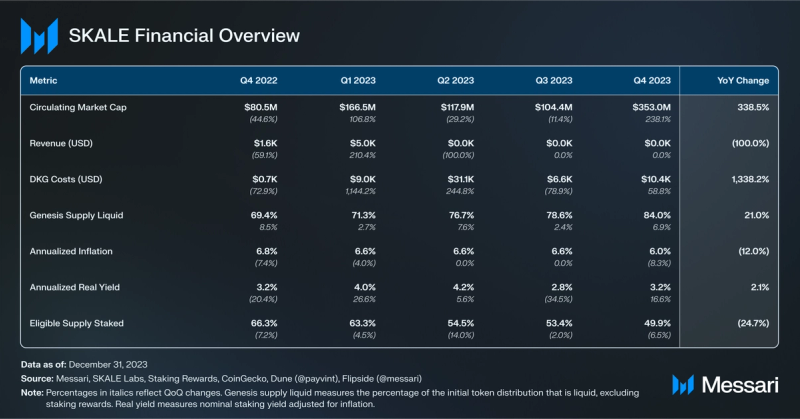
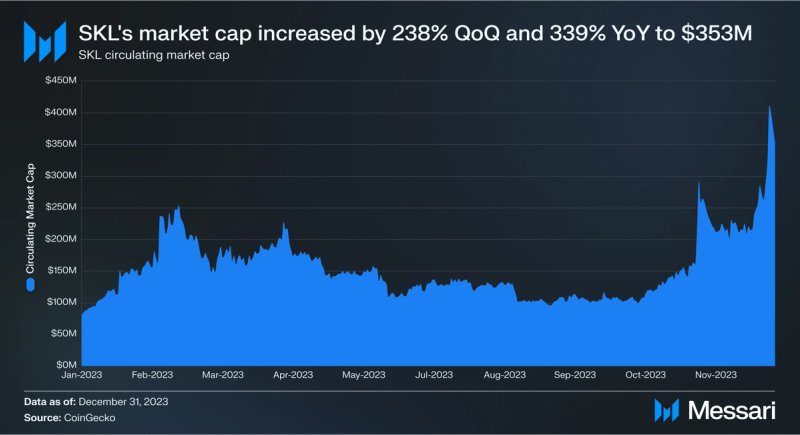
As a whole, the crypto market rebounded in Q4’23, and SKL was no exception. Its circulating market cap increased by 238% QoQ to $353 million. Its growth also outpaced its peers, as its market cap rank increased from 185 to 147 QoQ.
The SKL token has three primary use cases: SKALE chain subscription fees, network security (via validator staking), and governance.
Subscription Fees
SKALE has a unique revenue model because validator fees are paid by developers (SKALE chain owners) rather than the end user. SKALE still has a gas token (sFUEL) to combat network attacks like DDoS, but it does not have any monetary value, and users can receive it from token faucets. To generate fees, the protocol instead charges developers a subscription fee in SKL for creating their own SKALE chain. This fee is distributed to validators (and then passed on to delegators). On September 28, a governance proposal was posted on SKALE’s forum, breaking down SKALE’s subscription fee model into the following three phases:
- Phase 1 emphasized growth over revenue. The network was in this phase from launch in October 2020 until Q4’23. To incentivize growth in a loss leadership model, grants via the Protocol Development Fund were utilized for the majority of chain payments. These tokens were paid to a growth pool and distributed to developers and builders rather than validators. Thus far, revenue has only included ETH payments made by chain owners to cover the gas costs of running a SKALE chain.
- Phase 2 introduced a static price curve for chain fees. It starts at $3,600 per chain per month in SKL and can go up to $83,333. This figure aims to increase the fees distributed to validators, which can offset inflationary pressure without creating too high of a financial burden for developers. Phase 2 is expected to last 12-18 months, beginning in Q1’24.
- Phase 3 will look to introduce a fully dynamic price curve for chain fees. The dynamic price curve will aim to have a target price and automatically adjust itself based on the network’s supply change. The network load is defined as the percentage of total validator resources being used across all active SKALE chains. A higher network load leads to increased cost and vice versa.
The technical implementation for subscription fees will also be rolled out in a phased approach:
- Stage 1 will introduce onchain payment functionality for SKALE chains and rewards-claiming functionality for validators. However, a committee composed of three core developers, three validators, and three ecosystem builders will be required to arbitrate cases where SKALE chains or validators fail to meet the payments or requirements.
- Stages 2 and 3 will automate more of the process onchain and add additional features, although the committee will still have blacklist authority. Stage 2 is proposed to launch on July 1, 2024, and Stage 3 on July 1, 2025.
The aforementioned governance post proposes to transition SKALE from Phase 1 to Phase 2. In early December, the proposal was passed via a Snapshot vote with 1.4 billion SKL votes. SKALE subscription fees (Phase 2 of economic model, Stage 1 of technical implementation) went live on mainnet following quarter end, with the first payments due February 1, 2024.
Network Security Costs and Incentives
SKALE validator operations, including staking and rotation, occur on Ethereum via the SKALE manager smart contract. The SKALE manager runs distributed key generation (DKG) to generate Boneh–Lynn–Shacham (BLS) keys for each node. In the past five quarters, this computational cost has outweighed revenue generated by around $58,000 to $7,000. However, this relationship should quickly flip once SKALE chain payments begin in Q1’24.
Since launch, most validator rewards have come from inflation. SKL has a fixed total supply, with one-third allocated to validator rewards. So far, around 45% of this validator allocation has been distributed. At the end of Q4’23, SKL’s annualized inflation was at 6.0%. Note that this figure measures the annualized rate of tokens issued for validator rewards (67.4 million SKL in Q4’23) compared to the genesis supply of tokens allocated for non-staking rewards purposes (4.69 billion SKL). The inflation rate will continue to decline until all tokens are liquid. SKALE subscription fees aim to replace inflation as the primary payment to validators. The proposal’s goal is to have 90% of validator rewards come from fees, instead of inflation, by Q4 2027.
Beyond validator rewards, there is also inflationary pressure coming from token unlocks to other buckets of SKL’s initial distribution. Genesis supply liquid measures the percentage of tokens from the initial distribution that are liquid, excluding tokens for staking rewards. By the end of Q4’23, SKALE’s genesis supply liquid was at 84.0%, with another 1.9% unlocking in October to the team.
While the vast majority of validator rewards currently come from inflation, SKL’s real yield has still been positive since not all tokens are staked. As of the end of Q4’23, SKL’s real yield was 3.2%.
Token-Based Governance
On the last day of Q2’23, a Snapshot vote to institute a proposed governance system passed, with 1.3 billion SKL voting affirmatively. Staked SKL can participate in governance votes, whose scope will initially include network economic parameters such as subscription fees, inflation, slashing penalties, minimum stake requirements, and more. Voting will occur on offchain voting platform Snapshot. In order to execute proposals onchain, the plan is to use SafeSnap, a Snapshot plugin that integrates Safe (formerly Gnosis Safe) with Snapshot. With SafeSnap, passed proposals will need to be executed onchain by the owners of the Safe multisig. The Safe owners will also have veto power over a passed proposal. For more details on this system, refer to the Q2 report.
Network Analysis

Usage

Average daily transactions increased by 26% QoQ and 136% YoY to 908,000. With the number of SKALE chains remaining constant QoQ, the increased activity was driven by more usage on the existing chains. Web3 protocol Exorde and gaming hub Nebula accounted for the majority of transactions across SKALE chains. In particular, Nebula contributed most to overall growth, seeing average daily transactions increase by 525% QoQ to 352,000. See the Ecosystem Section below for a detailed breakdown of usage by SKALE chain.
Security and Decentralization
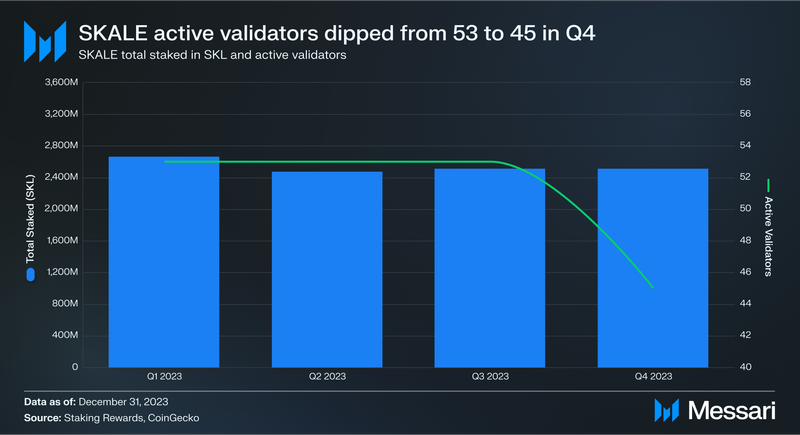
After remaining steady at 53 for most of 2023, the number of SKALE validators decreased to 45 in Q4, with a current total of 115 active nodes in the network. Validators receive an even split of SKL rewards, assuming they meet the performance criteria. Splitting the rewards creates an incentive for entities to operate more than one validator. At the end of Q4, there were 27 entities running validators.
SKALE validator nodes are segmented into up to 128 virtualized subnodes via a containerized architecture. A single validator can have its various subnodes acting as validators for up to eight SKALE chains. The pool of virtualized subnodes rotates among SKALE chains, with assignments set by the SKALE manager smart contract on Ethereum. The number of node rotations was flat QoQ, with the number of DKG transactions remaining at 384.
Total SKL staked also remained flat QoQ at 2.5 billion. However, total staked in USD increased by 216% QoQ to $176 million due to SKL’s price appreciation.
Upgrades and Roadmap
The biggest protocol release from the quarter was the upgrade to Metaport 2.0 near the end of November. Metaport is the UI widget for the SKALE bridge which enables token transfers between SKALE chains. Metaport 2.0 updates include RainbowKit support, routed transfers, and a revamped UI.
In mid-November, SKALE Labs revamped the SKALE Portal. On top of hosting Metaport 2.0, the portal also surfaces active SKALE chains and aggregated data. For further analytics, SKALE Labs also published Dune dashboards. Because Dune doesn’t feature SKALE tables yet, the data is currently being uploaded by SKALE Labss. Planned additions to the SKALE Portal include a portfolio page, broader bridging options, a curated dApps page, and more.
The most significant upcoming release is Levitation and SKALE Ganymede (SKALE G), which were proposed in a SKALE Improvement Proposal in Q2’23. The Levitation protocol aims to enable ZK-rollups to connect to the SKALE Architecture with rollup connectivity to the Ethereum Mainnet. In addition, SKALE G will be a general-purpose ZK-rollup launched as a SKALE chain. These solutions will increase the amount of security on SKALE chains derived from Ethereum, further scaling capabilities. They will also introduce a different revenue model with gas fees.
The mainnet launch is expected in Q4 2023 but is subject to change based on the actual progress of the SKALE Project. The proposal is also dependent on a successful onchain vote to push the source code into production. For more details on Levitation and SKALE G, refer to the Q2 report.
Ecosystem Overview

Popular Chains
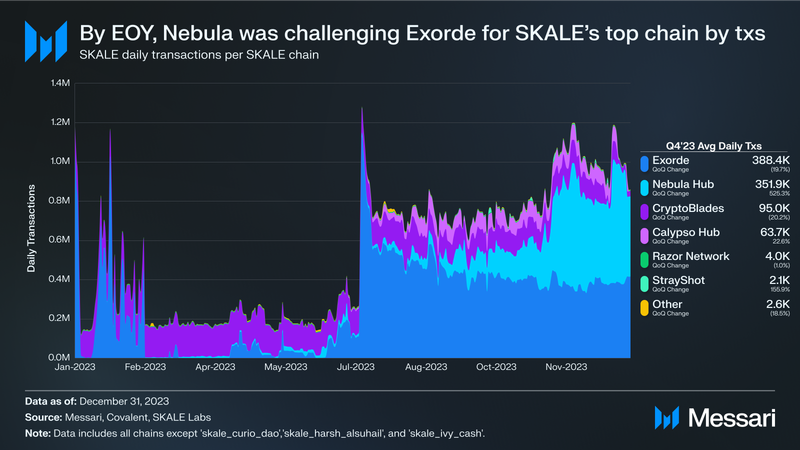
The growth in transactions across all SKALE chains was largely driven by gaming hub Nebula, whose average daily transactions grew 525% QoQ to 352,000. The SKALE network features both dapp-chains, like Exorde and CryptoBlades, and hubs. Hubs are chains that are shared by multiple applications, often from a similar sector.
Nebula’s growth was driven by games launched in Q2 and Q3 that saw more usage, notably P2E motorcycle game MotoDex, fantasy football platform 5tars, and P2E cricket game CricketFly by Gamifly. The launch of several new games on Nebula also drove growth in Q4, including augmented reality, walk-to-earn application dexGO; social, open-world hotel game Bit Hotel, P2E trading card game Spells of Genesis, P2E clicking game Ballers City, and P2E puzzle game Yomi Block Puzzle.
By the end of the quarter, Nebula was challenging Exorde for SKALE’s top chain by daily transactions. Regardless, Exorde still finished ahead, averaging 388,000 daily transactions in Q4. Exorde is an information platform that incentivizes users to collect and submit data from social networks. Exorde uses said data to create sentiment ratings, identify trends, and to power other analytical tools.
CryptoBlades featured the third-highest transaction count among chains at 95,000, a 20% QoQ decrease. CryptoBlades is a multichain Play-to-Earn PVP game.
NFT hub Calypso’s average daily transactions grew by 23% QoQ after increasing by almost 14,400% QoQ in Q3. Untitled Platformer, which features P2E platform games, continued to account for the majority of activity on Calypso following its Q2 launch.
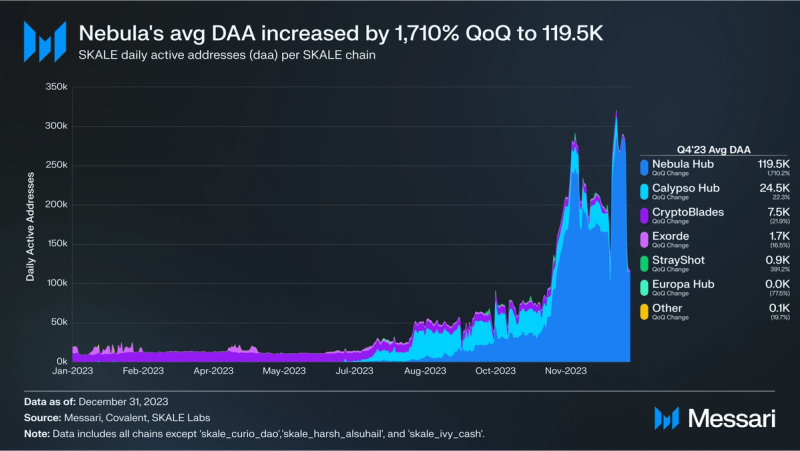
Nebula continued its strong growth from last quarter, increasing average daily active addresses by 1,700% QoQ to 112,000 after a 10,700% QoQ increase in Q3. Nebula sustained notable growth in the month of November, going from 35,000 to 197,000 active addresses. Activity grew again in the second half of December, peaking at an all-time high of almost 287,000 active addresses on December 22.
After growing by 20,500% in Q3, Calypso’s average daily active addresses increased by 22% QoQ in Q4. Untitled Platformer, which features P2E platform games, continued to account for the majority of activity on Calypso following its Q2 launch. At the end of November, Untitled underwent an upgrade, switching from web3.unity to Eidolon to improve performance and compatibility across games. In Q4, new launches on Calypso included online board game Pixudi and data provenance protocol ScoreDetect.
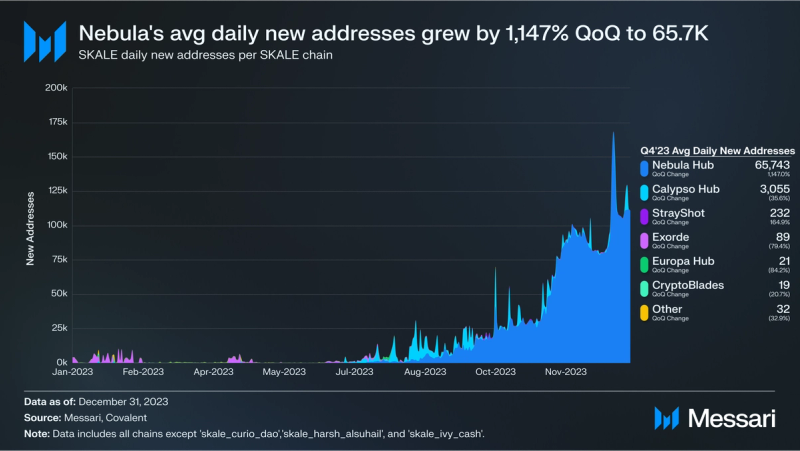
Nebula continued to account for the majority share of new addresses on the SKALE network. After growing by 22,900% QoQ in Q3, its average daily new addresses increased by over 1,100% QoQ in Q4 to 66,000. Similar to active addresses, significant growth occurred in the month of November. Nebula sustained over 100,000 daily new addresses for the last two weeks of the quarter, peaking at 168,000 new addresses on December 20.
After growing by 5,100% QoQ in Q3, Calypso’s average daily new addresses pulled back a little, down 36% QoQ to almost 3,100.
Of the other top chains by new addresses, only StrayShot sustained a QoQ increase in average daily new addresses, up 165% QoQ to 232. In mid-October, StrayShot announced a partnership with the BigBallerBrand family, including NBA players LaMelo and Lonzo Ball.
DeFi

The Europa Hub aims to solve potential liquidity fragmentation problems that arise with app-chain ecosystems by providing a central DeFi liquidity hub. Europa development is led by the Ruby Exchange team, with plans to eventually transition to a community-owned Hub.
Ruby Exchange is an AMM-based DEX featuring a “4Pool” consisting of stablecoins USDP, DAI, USDT, and USDC. At the end of Q3, TVL in the 4Pool stood at $370,000, a 31% QoQ decrease. Note that Ruby has had TVL since June 2022 but DefiLlama’s data only begins in March 2023.
SKALE does not currently support any native stablecoins; each of the four is bridged from Ethereum. The Europa bridge employs a multisig on top of the underlying inter messaging agent (IMA) bridge. The IMA bridge is trustless, as it uses the same mechanisms for security as SKALE’s consensus protocol. As such, the multisig can introduce additional trust assumptions depending on the level of control the chain owner gives to the multisig. The Europa bridge uses a 3/5 multisig with the following signers:
- Ruby Exchange, an AMM-based DEX.
- Impossible Finance, a launchpad that facilitated the RUBY initial DEX offering (IDO) on Binance Smart Chain.
- Boot Finance, a DeFi protocol that planned to build on SKALE prior to a hack. It has not had any activity on its Twitter or Medium account since May 19.
- 01Node and Stakin, both staking operators on SKALE.
As noted above, the Ruby Exchange team plans to move chain control to a community-owned, onchain governance structure to minimize multisig-related attack vectors.
Beyond the 4Pool, Ruby Exchange also features pools that pair USDP with other tokens, including RUBY, SKL, ETH, and more. At the end of Q4, TVL in these pools stood at $550,000. However, DefiLlama classifies these pools in their Yield category so they were excluded in this report to avoid double counting.
In Q4, SKALE Labs announced partnerships with several DeFi protocols that plan to launch on SKALE in 2024, including structured products protocol Dirac, CLMM-based DEX ReHold, and “no-loss” lottery protocol Savvio.
Development and Growth
SKALE Labs announced partnerships with several projects in Q4 that will go live in 2024, including with first-person shooter game Haven’s Compass, fan engagement platform Sportzchain, AI agent social network Chirper.ai, onchain role playing game Cryptopia, AI photo protection application Overlai, multiplayer action game Katana Inu, and player-versus-player game WarEden.
At the end of Q3, SKALE Labs launched the SKALE Ecosystem Accelerator Program (SEA Program) to help applications grow by leveraging infrastructure and content creator partnerships. In Q4, several new partners were announced, including Magic Square, Yoda Labs, PixelRealm (formerly NFTb), JR Studio, and Arcadia. SKALE Labs also announced a partnership with grant funding platform Granted to further fundraising accessibility on SKALE.
Beyond the SEA Program, ecosystem partnerships and growth will generally be spearheaded by the N.O.D.E. Foundation. The Foundation is still allocating from its $100 million ecosystem fund announced in February 2022 to attract new projects and partners.
Closing Summary
Q4 wrapped up an H2’23 featuring strong growth for SKALE. Onchain activity increased notably in the second half of the year, driven by gaming hub Nebula. Nebula’s average daily transactions, active addresses, and new addresses increased QoQ by 525%, 1,710%, and 1,147%. Growth was driven by existing games, including MotoDex, 5tars, and CricketFly, as well as new Q4 launches like dexGO.
2023 also featured several significant protocol developments, including the launch of a token-based governance system at the end of Q2 and the addition of chain pricing in Q4. With SKALE chain payments, SKALE will transition out of its loss leadership model and begin requiring SKALE chain owners to make monthly SKL payments to continue operating a chain starting February 1, 2024.



















